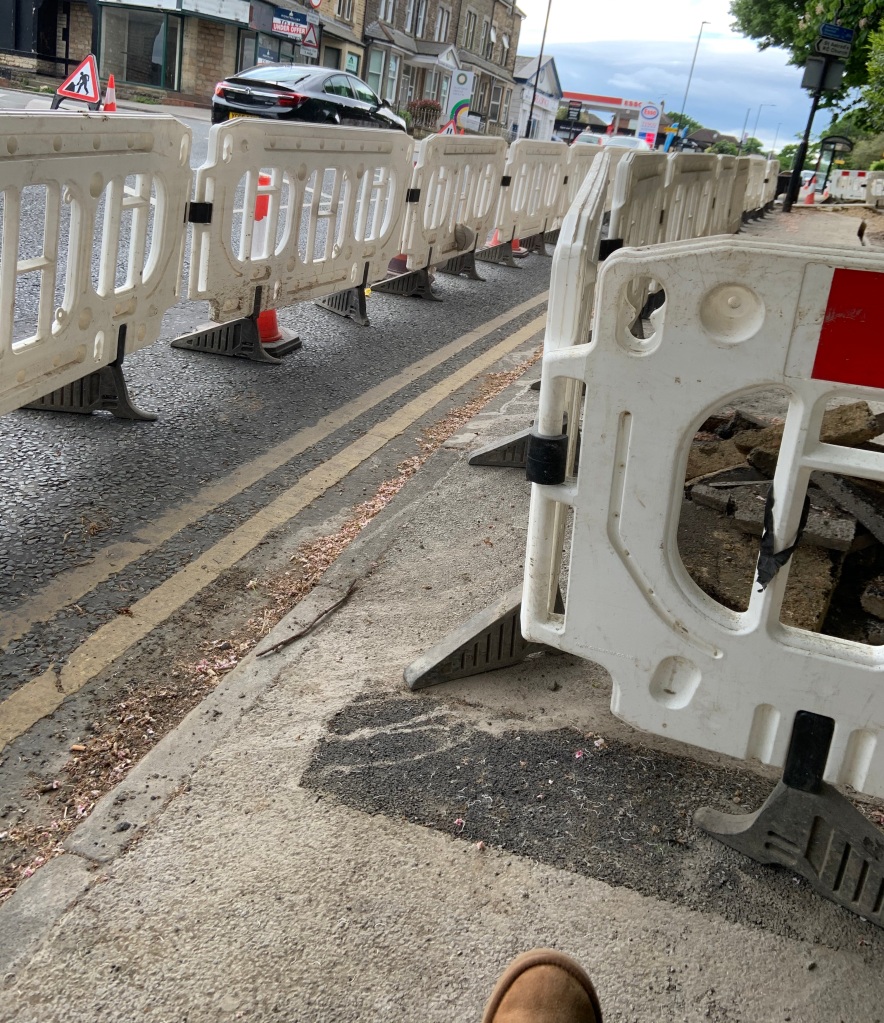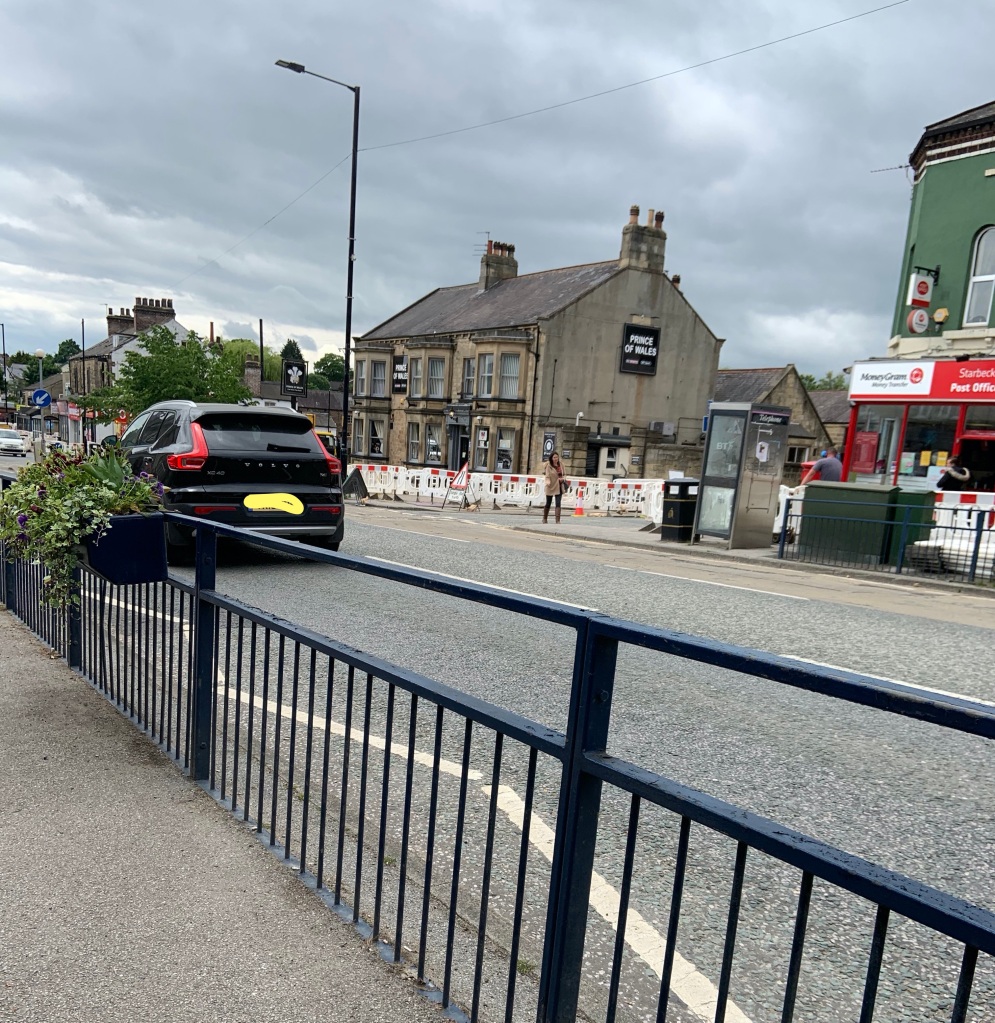Recently in Harrogate, just as the major wave of Coronavirus lockdown restrictions started to ease, there has been a lot of roadworks going on as TalkTalk’s company ‘FibreNation‘ has been rolling out full fibre broadband across Harrogate, Ripon and Knaresborough.
While this is great news for some, the actual process of installing the broadband cables has been frustrating for others as it has seen miles of pavements and roadways closed off or diverted whilst the construction workers are busy digging holes and laying cables.
Roadworks and diverted routes can often be a nightmare for those of us who have physical disabilities or are just a bit wobbly on our feet. Pathways which are usually wide, clear and have easy access via dropped kerbs & tactile paving, are now either off limits or you have to negotiate an assault course of blockades, trench coverings and signs to reach them.

Every day I walk my dog Lexi from my house to get to the cycle track that goes between Starbeck and Bilton. It is often a calm, enjoyable time for both of us. However, the added complication of roadworks and in some cases having to rely on the kindness of workmen, or even strangers passing by to negotiate them, just makes that lovely walk a much more stressful experience.
Although I don’t doubt that these works need to be done, or that the workmen go out of their way to help when asked, I do feel that when it comes to planning and carrying out the roadworks, little or no thought is put in to how they can make the area currently off limits physically accessible in the meantime.
One of the diversion measures carried out when roadworks are in place is to create a temporary pedestrian walkway on the side of the road using bollards and signage. As a wheelchair user who often has an assistance dog in tow, these alternative walkways are often too narrow and I end up having to attempt to nudge the bollards out of my way using my chair, (which is pretty much impossible!) or wait for a kind passer-by to help me. Sometimes there might not be a temporary walkway as the construction workers has deemed part of the path untouched by drills and plant machinery accessible to pedestrians. Unfortunately for those of us in wheelchairs, this gap is just not wide enough, so we have to take the dangerous route of wheeling down a busy road until we can find the next dropped kerb to take us onto a clearer, wider pavement. Sometimes it is not just wheelchair users who have to take this route. If you are unsteady on your feet and perhaps use a walking frame, it can be easier to walk a short distance on the road, against the traffic, than trying to step up a high kerb and negotiate unstable trench coverings to get to where you want to be.
Over the past few weeks when Fibre Nation construction workers have been working their way through the Starbeck area it has led to me becoming acutely more aware of my access requirements and how, if they are compromised, it could led to having to put myself in more dangerous situations as a wheelchair user. In once instance, the construction workers were digging up an entire stretch of road to install the cables and unfortunately I soon realised that my only other option of a pavement walkway to get where I needed to be was inaccessible due to the lack of dropped kerbs on that side of the road. The only way I was able to travel to my destination was to drive on the road in my wheelchair for about 160 metres (0.1 miles), constantly checking around me and over my shoulder for any cars & hoping that I wouldn’t be holding anyone up.

I don’t know how long these roadworks will take to complete, but it has made me think that the companies and organisations involved in planning such construction work need to consider how their work will impact both vehicles and pedestrians (including those with mobility issues) and create diversions and alternative routes that will be accessible for everyone during the scheduled disruption.
Here are some ideas that I think could be implemented:
- In the weeks and days leading up to construction work being carried out around residential areas, post notices to all the houses in the affected area informing them of what work is due to be carried out, what the disruption could likely be for those residents and how long it is likely to last for. (I’d previously thought this should have been happening, but as I have had no information posted to me before workmen had arrived and blocked the driveway, this mustn’t be the case.) Also, give details on how you can get help & support if you have issues with access to your home or getting round your local area whilst the work is being carried out.
- When carrying out construction work on a particular stretch of road/pavement, make sure that you:
- Leave enough space on the pavement so that a large mobility scooter would be able to fit through and exit the pavement via the nearest dropped kerb. If you can get it right for those who need the most room, you can get it right for everyone!
- Give clear signage to nearby accessible diverted routes for pedestrians.
- Check that the alternative route is wheelchair accessible. I.e – the pavement is wide enough for a large power chair/mobility scooter to drive down with no obstructions (cars parked on the kerb, cones etc…) and that it can easily be accessed via dropped kerbs along the route.
- If an alternative pedestrian route needs to be created along the roadside, make sure it is wide enough for a large power chair or mobility scooter to fit through and that you can get from and to the nearest pavement to the roadside route via a dropped kerb.
- Encourage managers of construction companies and team members from across all areas and sectors in those companies to attend disability awareness training courses run by or actively involving disabled people!

Having experienced the onslaught of numerous roadworks in my local area over the past month, it has made me realise how much extra planning and negotiating I have to do sometimes as a wheelchair user to get where I need to be. I’ll be glad when this current lot of work is finished and my usual routes are clear and accessible again, but I know I’m not the only one who struggles getting about when roadworks are out, and if some of these small changes can be implemented as suggested, it’d make a whole load of difference for a number of people!

I encounter the same problem having to walk with a rollator on Mayfield grove with bad car parking and parking incorrectly at the shops near where Strawberry Dale connects. Also the lack of shops, bars and cafes with disabled access and amenities in the Harrogate area.
LikeLike